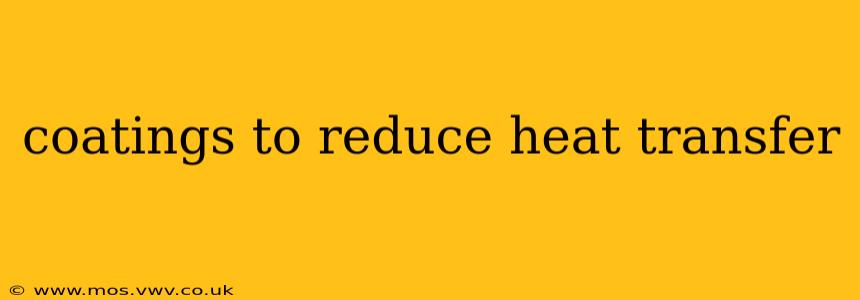Heat transfer is a ubiquitous phenomenon impacting various industries, from aerospace to construction. Minimizing unwanted heat transfer is crucial for energy efficiency, material protection, and optimal performance in numerous applications. This comprehensive guide explores various coatings designed to reduce heat transfer, examining their mechanisms, applications, and limitations.
What are the Different Types of Coatings Used to Reduce Heat Transfer?
Several coating types excel at reducing heat transfer, each operating through different mechanisms. These include:
-
Insulating Coatings: These coatings work by trapping air or other gases within their porous structure, creating an insulating layer that significantly reduces conductive and convective heat transfer. Examples include aerogel coatings and polyurethane foam coatings. The effectiveness of these coatings largely depends on the porosity and the trapped gas's thermal conductivity.
-
Reflective Coatings: These coatings minimize radiative heat transfer by reflecting incoming infrared radiation. Common materials include metallic coatings (e.g., aluminum, silver), ceramic coatings (e.g., zinc oxide), and specialized paints with high infrared reflectivity. The reflectivity of these coatings is highly dependent on the surface finish and the wavelength of the radiation.
-
Low-Emissivity Coatings (Low-E Coatings): These coatings are specifically engineered to have low thermal emissivity, meaning they emit less infrared radiation. They're commonly used in windows to reduce heat loss in winter and heat gain in summer. These coatings often incorporate metallic or metallic oxide layers within a transparent matrix.
What are the Applications of Heat Transfer Reducing Coatings?
The applications of heat-reducing coatings are vast and span diverse industries:
-
Building and Construction: Reducing heat transfer in buildings is crucial for energy efficiency. Coatings applied to roofs, walls, and windows can significantly decrease energy consumption for heating and cooling.
-
Automotive Industry: Heat-resistant coatings are essential in protecting engine components, exhaust systems, and other high-temperature parts from damage. They also improve fuel efficiency by reducing heat loss.
-
Aerospace Industry: In aircraft and spacecraft, minimizing heat transfer is critical for protecting sensitive components from extreme temperatures and improving fuel efficiency.
-
Electronics: Heat-reducing coatings are vital in electronic devices to prevent overheating and maintain optimal performance. They're used to protect components from high temperatures generated during operation.
-
Industrial Processes: Many industrial processes involve high temperatures, and coatings can help protect equipment and improve efficiency.
How Effective are Heat Transfer Reducing Coatings?
The effectiveness of heat transfer reducing coatings depends on several factors, including:
-
The type of coating: Different coatings have different levels of effectiveness, depending on the mechanism by which they reduce heat transfer.
-
The thickness of the coating: Thicker coatings generally provide better insulation.
-
The surface to which the coating is applied: The thermal properties of the substrate material also influence the overall effectiveness of the coating.
-
Environmental conditions: Temperature, humidity, and other environmental factors can affect the performance of the coating.
What are the Advantages and Disadvantages of Using Heat Transfer Reducing Coatings?
Advantages:
- Energy savings: Reduced heat transfer leads to lower energy consumption for heating and cooling.
- Improved material protection: Coatings protect materials from high temperatures and thermal shock.
- Increased lifespan of components: Protecting components from excessive heat extends their lifespan.
- Enhanced performance: Reducing heat improves the efficiency and performance of various systems.
Disadvantages:
- Cost: Some high-performance coatings can be expensive.
- Application complexity: Applying some coatings may require specialized equipment and techniques.
- Durability: The durability and longevity of coatings can vary depending on the environment and application.
- Potential environmental impact: The manufacturing and disposal of some coatings may have environmental consequences.
What are Some Examples of Specific Coatings Used to Reduce Heat Transfer?
Several specific coatings exemplify the variety available:
- Aerogel coatings: Known for their exceptional insulation properties due to their extremely low density and high porosity.
- Vacuum insulation panels (VIPs): These panels contain a vacuum inside a sealed envelope, minimizing heat transfer through conduction and convection.
- Phase change materials (PCMs): PCMs absorb and release latent heat, providing thermal buffering and reducing temperature fluctuations.
How Do I Choose the Right Heat Transfer Reducing Coating?
Selecting the appropriate coating requires careful consideration of several factors:
- The application: The specific application dictates the required thermal properties and durability.
- The substrate material: Compatibility between the coating and the substrate is crucial for adhesion and performance.
- Environmental conditions: The coating must withstand the environmental conditions to which it will be exposed.
- Cost: The overall cost, including material and application, must be considered.
Choosing the right coating to reduce heat transfer is crucial for optimizing performance, improving energy efficiency, and protecting materials in various applications. Understanding the different types of coatings, their mechanisms, and their limitations enables informed decision-making for specific needs. Consult with experts and conduct thorough research to ensure the selection of the most suitable and effective coating for your application.
